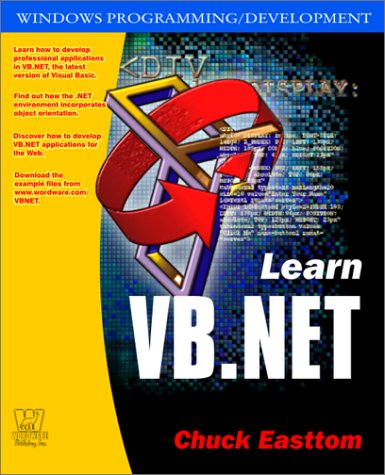Learn Vb Net 1st Edition by Chuck Easttom ISBN 1556229526 9781556229527 by Chuck Easttom 1556229526 instant download after payment.
Learn Vb Net 1st Edition by Chuck Easttom - Ebook PDF Instant Download/Delivery: 1556229526, 9781556229527
Full download Learn Vb Net 1st Edition after payment

Product details:
ISBN 10: 1556229526
ISBN 13: 9781556229527
Author: Chuck Easttom
When Visual Basic was introduced in 1991, it revolutionized Windows programming. The latest version of Visual Basic, VB.NET, continues that trend, and now has all the power and functionality of other mainstream languages. Learn VB.NET covers all aspects of VB.NET in a format designed to show novice programmers how to develop professional applications. Beginning with basic programming techniques, the author leads readers through the fundamentals of object-oriented programming, Microsoft's .NET architecture, ADO.NET, and object models. Additionally, readers will learn about designing software, testing and debugging, and developing Web-based applications. A brief introduction to object-oriented software design with Unified Modeling Language is provided, along with a discussion of TCP/IP programming.
Learn Vb Net 1st Table of contents:
Part I: Getting Started with VB.Net
- Chapter 1: Introduction to VB.Net and .NET Framework
- What is VB.Net?
- Overview of the .NET Framework (CLR, CTS, CLS, FCL)
- Why Learn VB.Net?
- Setting up your Development Environment (Visual Studio Installation)
- Your First VB.Net Program: "Hello, World!"
- Understanding the Visual Studio IDE
- Chapter 2: VB.Net Fundamentals: Syntax and Structure
- Basic Program Structure
- Comments, Keywords, and Identifiers
- Data Types (Integers, Strings, Booleans, etc.)
- Declaring Variables and Constants
- Operators (Arithmetic, Relational, Logical, Assignment)
- Type Conversions (Implicit and Explicit)
- Chapter 3: Control Flow Statements
- Conditional Statements (If...Then...Else, Select Case)
- Looping Constructs (For...Next, While...End While, Do...Loop, For Each...Next)
- Exiting Loops and Conditions
- Chapter 4: Procedures and Functions
- Understanding Subroutines (Subs)
- Understanding Functions
- Passing Arguments (ByVal, ByRef)
- Return Values
- Scope of Variables
- Overloading Procedures
Part II: Object-Oriented Programming (OOP) in VB.Net
- Chapter 5: Introduction to Object-Oriented Programming
- Concepts of OOP (Encapsulation, Inheritance, Polymorphism, Abstraction)
- Classes and Objects
- Creating and Using Classes
- Properties and Fields
- Methods
- Chapter 6: Constructors and Destructors
- Default Constructors
- Parameterized Constructors
- Overloaded Constructors
- Finalize Method (Destructors)
- Chapter 7: Inheritance
- Base Classes and Derived Classes
- Overriding Methods (Overridable, Overrides)
- MyBase Keyword
- Abstract Classes and Methods
- Sealed Classes
- Chapter 8: Polymorphism
- Method Overloading (revisited)
- Method Overriding (revisited)
- Interfaces (Defining and Implementing)
- Chapter 9: Namespaces and Assemblies
- Organizing Code with Namespaces
- Importing Namespaces
- Understanding Assemblies
Part III: Building Windows Forms Applications
- Chapter 10: Introduction to Windows Forms
- Visual Studio Designer for Forms
- Common Controls (Buttons, TextBoxes, Labels, etc.)
- Handling Events (Click, TextChanged, etc.)
- Properties, Methods, and Events of Controls
- Chapter 11: Advanced Windows Forms Controls
- Group Boxes, Panels, Tab Controls
- List Boxes, Combo Boxes, Checked List Boxes
- Radio Buttons and Check Boxes
- Picture Boxes, Timers
- Menus (MenuStrip, ContextMenuStrip)
- Toolbars and Status Strips
- Chapter 12: Dialog Boxes and User Input
- MessageBox
- OpenFileDialog, SaveFileDialog
- FontDialog, ColorDialog
- InputBox
- Chapter 13: Error Handling and Debugging
- Types of Errors (Syntax, Runtime, Logic)
- Structured Error Handling (Try...Catch...Finally)
- Throwing Exceptions
- Debugging Techniques in Visual Studio (Breakpoints, Watch Window, Locals Window)
Part IV: Data Access and Database Integration
- Chapter 14: Introduction to ADO.NET
- Overview of ADO.NET Architecture
- Connecting to Databases (SqlConnection)
- Executing Commands (SqlCommand)
- Data Readers (SqlDataReader)
- Chapter 15: Disconnected Data Access with DataSets
- Understanding DataAdapters
- Working with DataSets and DataTables
- Binding Data to Controls
- Updating Data in the Database
- Chapter 16: LINQ (Language Integrated Query)
- Introduction to LINQ
- LINQ to Objects, LINQ to XML
- LINQ to SQL (if applicable to the VB.Net version)
- Using LINQ with DataSets
Part V: Advanced Topics (Optional/Based on Book Scope)
- Chapter 17: File I/O and Streams
- Reading and Writing Text Files
- Working with Binary Files
- File and Directory Operations
- Chapter 18: Graphics in VB.Net (GDI+)
- Drawing Shapes and Text
- Working with Images
- Chapter 19: Deployment of VB.Net Applications
- ClickOnce Deployment
- MSI Installer Projects
- Chapter 20: Introduction to Web Development with ASP.NET (if included)
- Basic Web Forms concepts
- Controls for Web Applications
- Chapter 21: (Further topics like Multithreading, Reflection, etc., depending on the book's depth)
People also search for Learn Vb Net 1st:
learn vb net
home and learn vb net
learn vb net w3schools
microsoft learn vba
learn vb net online
Tags: Chuck Easttom, Learn, Vb



